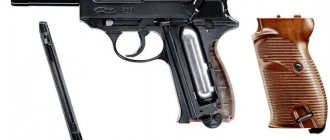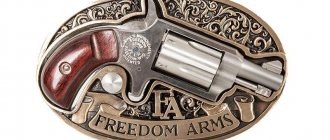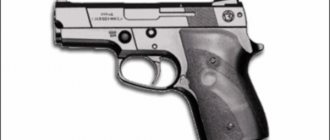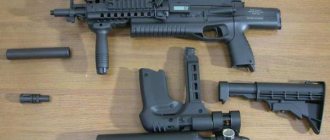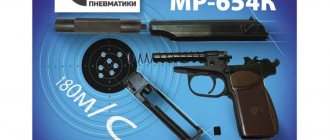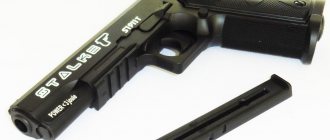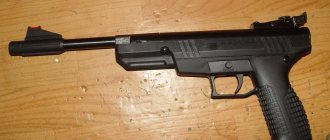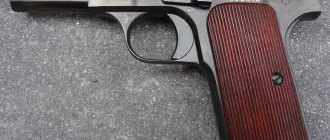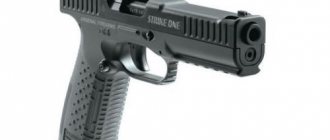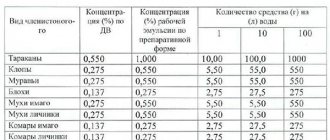Crosman C31 Air Pistol Review
Getting to know the pistol, what is good about it and what is not so good. This device, produced by the famous US company Crosman Corporation, shoots using carbon dioxide contained in a standard twelve-gram canister. Which gives the metal ball quite a decent speed - more than 150 meters per second. Thanks to the plastic body, the weight of the pistol is light, so you can shoot for a long time without getting tired.
Let's note the attractive qualities of the model:
- Quite reasonable cost (about 4 thousand rubles).
This model has a very economical consumption of carbon dioxide - you can easily fire up to a hundred shots from one refill.
- Lightness that does not leave your hands tired.
- Not the smallest muzzle energy for such a “baby” - three and seven tenths of a joule.
- High initial speed of the flying charge.
- Volume store.
Let’s not ignore the shortcomings of the Crossman s 31 pistol:
- Due to the smoothness of the barrel, bullets are not placed very tightly over long distances.
- The plastic body, although of very high quality, is inferior to metal.
- Aiming devices are fragile and easy to lose.
- Over time, the clip no longer holds the balls tightly.
Photo of the Crosman C31 air pistol
Crosman C31 price
It is also worth talking separately about the cost of this weapon. Sometimes manufacturers inflate prices for their weapons, even if they are clearly not worth it. Fortunately, the Crosman company does not suffer from such a disease. The price of the Crosman C31 is low and quite affordable. To get a pistol, you will have to pay about 4,000 rubles (1,400 Ukrainian hryvnia). For comparison, you can consider other popular models. For example, Umarex Walther P38 from Umarex costs 7,000 rubles (about 2,500 hryvnia). And for the well-known Beretta M 92 FS from the same company you will have to pay more than 11,000 rubles (approximately 4,000 hryvnia).
View gallery
Specifications
Technical characteristics of the air pistol Crossman s 31:
| Characteristics | Indicators | Unit measurements |
| Type | gas cylinder | |
| Color | black | |
| Frame | made of rough plastic | |
| Descent | no adjustment possible | |
| Fuse | not automatic | |
| Shoots | steel explosive balls | |
| Fire | in semi-automatic mode | |
| The store includes balls | 18 | PC. |
| Smooth steel barrel length | 11,5 | cm |
| Weight | 680 | G |
| Length (full) | 21,5 | cm |
| Feeding with weighted CO2 canisters | 12 | G |
| Energy (muzzle) | 3,7 | J |
| The charge flies out with acceleration | 151 | m/s |
| You can make shots with one refill | 80-100 | PC. |
| Product price | from 4 000 | rub. |
Device
As already mentioned, the Crosman c31 pistol copies the famous Beretta firearm (the old Beretta 90two model). Only its body is made of weapons-grade plastic. The barrel is a movable type, made without rifling, made of steel. Steel and a magazine located inside the handle (but its lock is plastic). Eighteen copper-plated metal balls can be placed in the magazine.
The power source - a gas canister - takes its place in the handle, like the magazine. To insert it there, you need to slightly move the pad on the handle by pulling it back. And to pull out the clip you need to move the lever of the bracket located on the trigger hook. To the right of this hook is the safety (non-automatic).
In the photo there is a place for a can of carbon dioxide
Open type sighting devices are a front sight with a rear sight, which are also made of plastic. They have special fiber-optic thread-like inserts (colored). If you want to experiment with laser sights, please do so. There is a place for them.
Equipment
In addition to the weapon itself, the blister (this is the form the pistol is supplied in) contains:
- Manual printed in several languages. This is a leaf folded several times.
- A holster made of synthetic material with a pocket for a spare clip.
Crosman C31 air pistol and holster for it
Principle of operation
So, let's start - press the trigger. At the same time, the trunk slowly moves forward. As a result, the iron ball, which is pushed by the spring of the clip and clamps the spring cone on top, comes out onto the axis of the barrel channel. The barrel carries it along, then a blow to the valve and the release of a powerful gas jet. She goes all the way into the trunk, taking the ball with her.
Possible breakdowns
Since the device body consists of two plastic halves fastened with screws, the connection cannot withstand long assemblies and disassemblies. The grooves become larger and the screws dangle in them. There is a simple repair method: you need to take polycarbonate or PVC and mix it with plastic. Heat until melting and strengthen the grooves. And at the same time the place (also weak) where the cone spring rests.
After numerous reloads, the spring that holds the balls in the magazine begins to weaken. And then the ball, which turns out to be the outermost one, does not reach the barrel channel. However, if you turn the weapon over with the clip facing up, you can fire a shot.
Often the plastic latch with which the magazine is equipped also breaks. It is poorly repairable, so you need to treat this part with particular care and attention.
Another trouble that happens quite often: carbon dioxide begins to “poison” as it comes out of the can. It happens that everything goes away if the gun lies idle for a long time. The reason is the gasket of the cylinder. Perhaps it is crooked or needs to be replaced.
Well, if something more serious happened, you need to take your pneumatic gun to the master - let him “cure it.”
Disassembly
Disassembly (incomplete):
- Move the bracket down and remove the clip.
- Remove the plastic handle plate.
- Having cocked the hammer, we move the bolt frame back and up, trying not to lose small parts (in particular, the spring).
- The barrel will be removed after removing the pistol from the safety catch.
- Now you can clean the dust and dirt that has accumulated in the bore and the area for the cartridge. And then lubricate all parts made of metal.
Assembly:
- Let's start with the barrel - insert it.
- Time to put the spring in place, as well as the small part it should rest against.
- After installing the shutter, put on the casing.
All is ready! The video shows a partial disassembly of the Crosman C31 air pistol:
You. Grossman Years of War
1941
The people are immortal
I. August
On a summer evening in 1941, heavy artillery was coming along the road to Gomel.
The guns were so large that the experienced, experienced convoys looked with interest at the colossal steel barrels. Dust hung in the evening air, the faces and clothes of the artillerymen were gray, their eyes were inflamed. Only a few walked, most sat on guns. One of the fighters drank water from his steel helmet, drops running down his chin, moistened teeth glistening. It seemed that the artillery crew number was laughing, but he did not laugh - his face was thoughtful and tired. "Air!" - the lieutenant walking ahead shouted in a drawn-out voice. Two planes were flying quickly over the oak forest towards the road. People anxiously watched their flight and exchanged words:
- This is ours!
- No, German.
And, as always in such cases, a front-line joke was uttered:
- Ours, ours, where is my helmet!
The planes were crossing the road, and this meant that they were ours: German cars usually, upon seeing the column, turned to a course parallel to the road.
Powerful tractors dragged the guns along the village street. Among the white daubed huts, small village front gardens planted with curly golden balls and red peonies glowing in the sunset rays, among women and white-bearded old men sitting on the rubble, among the mooing of cows and the colorful barking of dogs, the huge cannons floating in the peaceful world looked strange and unusual. evening village.
Near the small bridge, groaning from a terrible, unusual weight, there was a passenger car, waiting for the guns to pass. The driver, obviously accustomed to such stops, looked at the soldier drinking from his helmet with a smile. The battalion commissar sitting next to him kept looking forward to see if the tail of the column was visible.
“Comrade Bogarev,” said the driver with a Ukrainian accent, “maybe we’ll spend the night here, otherwise it will get dark soon.”
The battalion commissar shook his head.
“We have to hurry,” he said, “I need to be at headquarters.”
“We won’t drive along these roads at night anyway, we’ll spend the night in the forest,” said the driver.
The battalion commissar laughed.
- What, do you want milk?
- Well, then, of course, drink some milk and eat some fried potatoes.
“Or even goose,” said the battalion commissar.
- Isn’t there a hib? — the driver asked with cheerful enthusiasm.
Soon the car drove onto the bridge. The white-headed children ran after her.
“Guys, guys,” they shouted, “take the cucumbers, take the tomatoes, take the pears,” and they threw cucumbers and hard, unripe pears at the half-lowered car window.
Bogarev waved to the guys and felt a chill of excitement running through his chest. He could not, without a bitter and at the same time sweet feeling, see how the peasant children saw off the retreating Red Army.
Before the war, Sergei Aleksandrovich Bogarev was a professor in the department of Marxism-Leninism at one of the Moscow universities. Research work fascinated him, he tried to devote fewer hours to lecturing; Bogarev's main interest was in the research he began two years ago. Coming home from work and sitting down to dinner, he pulled out a manuscript from his briefcase and read it. His wife asked him whether he liked the food, whether the scrambled eggs were salted enough, he answered inappropriately; she got angry and laughed, and he said: “You know, Lisa, today I experienced real pleasure - I read Marx’s letter, it was only recently dug up in an old archive.”
And here is Sergei Aleksandrovich Bogarev - deputy head of the department of the Front Political Directorate for work among enemy troops. Sometimes he remembers the cool halls of the institute's manuscript depository, a table littered with papers, a lamp under a lampshade, the creaking of a movable ladder, which the head of the library moves from one bookshelf to another. Sometimes individual phrases from his unfinished work pop up in his brain, and he thinks about the questions that worried him so vividly and ardently.
The car runs along the front road. The dust is dark, brick-like, yellow dust, fine gray dust - it makes faces seem dead, clouds of dust stand over the roads at the front. This dust is raised by hundreds of thousands of Red Army boots, truck wheels, tank tracks, tractors, guns, small hooves of sheep, pigs, herds of collective farm horses, huge herds of cows, collective farm tractors, creaking carts of refugees, bast shoes of collective farm foremen and shoes of girls leaving Bobruisk, Mozyr, Zhlobin, Shepetovka, Berdichev. Dust is over Ukraine and Belarus, dust is swirling over Soviet soil. At night, the dark August sky turns purple with the angry blush of village fires. The heavy roar of aerial bomb explosions rolls through dark oak and pine forests, through tremulous aspen trees; green and red tracer bullets pierce the heavy velvet of the sky like white sparks, explosions of anti-aircraft shells flash, Heinkels loaded with high-explosive bombs hum tediously in the high darkness, the sound of their engines seems to say: “ve-z-zu, ve-z-z- zu". Old men, old women, children in villages, hamlets, seeing off the retreating fighters, tell them: “Drink some milk, my dears... Eat the cottage cheese, take the pie, son... Cucumbers for the road.” The old woman's eyes are crying and crying, looking for the face of her son among thousands of dusty, stern, tired faces. And the old women held out white bundles with gifts, asking: “Take it, take it, my dear, you are all in my heart, like dear children.”
German hordes were moving from the west. Skulls with crossbones, green and red dragons, wolf mouths and fox tails, and horned deer heads are painted on German tanks. Every German soldier carries in his pocket photographs of defeated Paris, destroyed Warsaw, disgraced Verdun, burned Belgrade, captured Brussels and Amsterdam, Oslo and Narvik, Athens and Gdynia. In every officer's wallet there are photographs of German girls and women with bangs and curls, in striped pajama pants; Each officer wears amulets - gold trinkets, strings of coral, stuffed animals with yellow beaded eyes. Everyone has a Russian-German military phrasebook in their pocket with simple phrases: “Hands up”, “Stop, stay still”, “Where are the weapons?”, “Surrender”. Every German soldier memorized: “Mleko”, “Kleb”, “Yayki”, “Koko”, “dz-dz” and the word “Come on, come on”. They were coming from the west.
And tens of millions of people rose to meet them from the bright Oka and wide Volga, from the harsh yellow Kama and the foaming Irtysh, from the steppes of Kazakhstan, from Donbass and Kerch, from Astrakhan and Voronezh. The people raised their defenses, tens of millions of loyal workers dug anti-tank ditches, trenches, dugouts, and pits. Noisy groves and forests lay silently with thousands of their trunks across highways and quiet country roads, barbed wire entwined factories and factory yards, iron turned like anti-tank hedgehogs in the squares and streets of our lovely green towns.
Bogarev was sometimes surprised at the ease with which he was able to suddenly, within a few hours, cut off his former life; he rejoiced in the fact that he remained reasonable in difficult situations and was able to act decisively and quickly. And most importantly, he saw that here, in the war, he preserved himself and his inner world, and people believed him, respected him and felt his inner strength. However, he was not satisfied with his work, it seemed to him that he was not close enough to the Red Army soldiers, to the core of the war, and he wanted to move from the Political Directorate to direct combat work.
He often had to interrogate German prisoners - most of them were corporals and non-commissioned officers. He noticed that the feeling of hatred for fascism, which tormented him day and night, during interrogations was replaced by contempt and disgust. Most of the prisoners behaved cowardly. They quickly and willingly named unit numbers, weapons, assured that they were workers who sympathized with communism, who had once been in prison for revolutionary ideas, and everyone said with one voice: “Hitler is kaput, kaput,” although it was quite obvious that internally they are sure of the opposite.
Only occasionally did we come across fascists who found the courage to declare in captivity their devotion to Hitler, their belief in the supremacy of the German race, designed to enslave the peoples of the world. Bogarev usually questioned them in detail - they had not read anything, not even fascist pamphlets and novels, they had not heard not only about Goethe and Beethoven, but also about such figures of German statehood as Bismarck, and the famous military names of Moltke, Frederick the Great, and Schlieffen. They only knew the name of the secretary of their district organization of the National Socialist Party. Bogarev carefully studied the orders of the German command. He noted in them a broad ability to organize: the Germans robbed, burned, bombed in an organized and methodical manner; the Germans knew how to organize the collection of empty cans at military bivouacs, they were able to develop a plan for the complex movement of a huge column, taking into account thousands of details, and punctually, with mathematical precision, carry out these details. In their ability to mechanically obey, to march thoughtlessly, in the complex and huge movement of the millions of soldiers constrained by discipline, there was something base, not characteristic of the free mind of man. It was not a culture of reason, but a civilization of instincts, something coming from the organization of ants and herd animals.
Improving your pneumatic
Of course, many owners of the Crosman c31 would like to increase accuracy. Craftsmen have figured out how to do this - there are detailed instructions on the Internet. Let's briefly say that you need to put a bushing machined from steel into the false barrel. Or rather, even two bushings: one with an internal diameter of 6 millimeters must be screwed into the bolt frame from the outside, the second (with an M10X1 thread inside) must be screwed into the first bushing.
Now about increasing power. In the place where the barrel hits the valve there is a small part that looks like a weight. It needs to be ground down a little - about a millimeter (on the side that is thicker).
Upgrade
Fans of precision shooting to improve accuracy install a false barrel - make an insert in the bolt frame - two bushings:
- the main one is made of stainless steel with internal thread M10x1;
- the outer one with a diameter of 6 mm fixes the false barrel outside the bolt frame.
To increase power, increase the swing of the shock valve. To do this, grind off a part that looks like a weight from the thick edge by 1 mm. After this modification, the weapon shoots more accurately at long distances.
